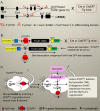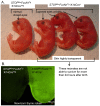Insights on FoxN1 biological significance and usages of the "nude" mouse in studies of T-lymphopoiesis - PubMed (original) (raw)
Review
Insights on FoxN1 biological significance and usages of the "nude" mouse in studies of T-lymphopoiesis
Zhijie Zhang et al. Int J Biol Sci. 2012.
Abstract
Mutation in the "nude" gene, i.e. the FoxN1 gene, induces a hairless phenotype and a rudimentary thymus gland in mice (nude mouse) and humans (T-cell related primary immunodeficiency). Conventional FoxN1 gene knockout and transgenic mouse models have been generated for studies of FoxN1 gene function related to skin and immune diseases, and for cancer models. It appeared that FoxN1's role was fully understood and the nude mouse model was fully utilized. However, in recent years, with the development of inducible gene knockout/knockin mouse models with the loxP-Cre(ER(T)) and diphtheria toxin receptor-induced cell abolished systems, it appears that the complete repertoire of FoxN1's roles and deep-going usage of nude mouse model in immune function studies have just begun. Here we summarize the research progress made by several recent works studying the role of FoxN1 in the thymus and utilizing nude and "second (conditional) nude" mouse models for studies of T-cell development and function. We also raise questions and propose further consideration of FoxN1 functions and utilizing this mouse model for immune function studies.
Keywords: FoxN1 gene; T-Lymphopoiesis.
Conflict of interest statement
Conflict of interest: We do not have conflict of competing financial interest.
Figures
Figure 1
Schematic diagram of Cre/CreERT-mediated _loxP_-deletion system in the FoxN1 gene in mice. (A) FoxN1 conditional gene knockout system : FoxN1 functional domain (exons 5 and 6, a DNA binding domain) is flanked by two loxP sites (termed “fx”). After introduction of Cre or CreERT transgene (Tg) into these mice by crossbreeding (termed as “X”), and induction with tamoxifen (TM, only for CreERT Tg), the _loxP_-flanked exons 5 and 6 are cut out (termed “ΔE5&6”), and the FoxN1 gene loses its function (knockout). (B) FoxN1 conditional transgenic system (under development): FoxN1 cDNA (exogenous FoxN1) driven by an enhanced promoter and followed by a GFP reporter gene will be targeted into a housekeeping gene, such as Rosa26. Meanwhile, a loxP flanked “_STOP_” cassette (_STOP_flox), a roadblock sequence, is placed upstream of FoxN1 cDNA to block FoxN1 expression initially. As soon as tamoxifen is administrated (for CreERT Tg), the roadblock _STOP_flox is deleted and transcription of exogenous FoxN1 cDNA is turned on, and accompanied by GFP expression. (C) FoxN1 resumption (loss- resumption) system : A _STOP_flox cassette (including two splice acceptors and a hygromycin cassette flanked by loxP sites) is inserted into the middle of the normal FoxN1 gene, for example, just after exon 6, which destroys normal FoxN1 splicing and silences FoxN1 transcription. After the introduction of CreERT Tg, such as K14-CreERT, into these mice, and induced activation of K14-CreERT with tamoxifen, the _STOP_flox is cut out, and endogenous FoxN1 expression resumes.
Figure 2
Observe mutant phenotypes in mice with prenatal (mediated by parents' Cre, without self Cre) deletion of FoxN1, or with both prenatal and postnatal (mediated by parents' and self Cre) deletion of FoxN1. (A) A representative result of genomic DNA PCR using primers shown in Fig. 1A. Linking this result with the phenotype, we found that homozygous fx/fx (_FoxN1_flox/flox) mice possessed ΔE5&6 recombination band but did not carry self eCre (EIIaCre - transgenic mouse from Jackson Lab #003724) - genotype #3 in the figure, did not show abnormal phenotypes in the skin and thymus. Therefore, the genotype #3 animals' ΔE5&6 recombination band came from their parents' eCre (their mother carried an eCre transgene). However, homozygous fx/fx mice carrying self eCre with a ΔE5&6 recombination band - genotype #4 in the figure, possessed abnormal phenotypes. (B) Table showing observed total fx/fx mice with/without self eCre Tg, linked to abnormal/normal phenotypes. Although they all have a ΔE5&6 recombination band, the abnormal phenotypes can only be seen in the mice with self eCre Tg.
Figure 3
Over-expression of FoxN1 in _STOP_flox-FoxN1 transgenic mice mediated by K14Cre results in neonatal lethality. (A) Image of eye opening can be seen in _STOP_flox_FoxN1_Tg-K14Cre+ neonates (right three neonates), but not in control _STOP_flox_FoxN1_Tg-K14Cre-neg neonate (left). (B) Green fluorescence is shown in _STOP_flox_FoxN1_Tg-K14Cre+ neonatal thymus (right), but not in control _STOP_flox_FoxN1_Tg-K14Cre-neg neonatal thymus (left).
Figure 4
Microarray results of FoxN1 target genes. Total RNAs were isolated from flow cytometry sorted TECs (CD45- MHC-II+) of young mice from ubiquitous-CreERT-mediated _FoxN1_-deleted (tamoxifen x5 to conditionally delete FoxN1 postnatally) thymic pool and WT thymic pool. (A) Number of affected molecules in top five bio-function groups; (B) Number and % of genes with upward (red) /downward (green) changes in total arrayed genes. Number and % of genes down to log2 ratio < -2 and up to log2 ratio > 2 are given; (C) One of the most involved genetic networks was the Toll-like receptor (TLR) pathway. As shown TLR4 was significantly increased after the FoxN1 was conditionally knocked out.
Similar articles
- Biological significance of FoxN1 gain-of-function mutations during T and B lymphopoiesis in juvenile mice.
Ruan L, Zhang Z, Mu L, Burnley P, Wang L, Coder B, Zhuge Q, Su DM. Ruan L, et al. Cell Death Dis. 2014 Oct 9;5(10):e1457. doi: 10.1038/cddis.2014.432. Cell Death Dis. 2014. PMID: 25299782 Free PMC article. - Thymopoiesis in mice depends on a Foxn1-positive thymic epithelial cell lineage.
Corbeaux T, Hess I, Swann JB, Kanzler B, Haas-Assenbaum A, Boehm T. Corbeaux T, et al. Proc Natl Acad Sci U S A. 2010 Sep 21;107(38):16613-8. doi: 10.1073/pnas.1004623107. Epub 2010 Sep 7. Proc Natl Acad Sci U S A. 2010. PMID: 20823228 Free PMC article. - Overexpression of Foxn1 attenuates age-associated thymic involution and prevents the expansion of peripheral CD4 memory T cells.
Zook EC, Krishack PA, Zhang S, Zeleznik-Le NJ, Firulli AB, Witte PL, Le PT. Zook EC, et al. Blood. 2011 Nov 24;118(22):5723-31. doi: 10.1182/blood-2011-03-342097. Epub 2011 Sep 9. Blood. 2011. PMID: 21908422 Free PMC article. - FOXN1 in thymus organogenesis and development.
Vaidya HJ, Briones Leon A, Blackburn CC. Vaidya HJ, et al. Eur J Immunol. 2016 Aug;46(8):1826-37. doi: 10.1002/eji.201545814. Eur J Immunol. 2016. PMID: 27378598 Free PMC article. Review. - FOXN1 Deficiency: from the Discovery to Novel Therapeutic Approaches.
Gallo V, Cirillo E, Giardino G, Pignata C. Gallo V, et al. J Clin Immunol. 2017 Nov;37(8):751-758. doi: 10.1007/s10875-017-0445-z. Epub 2017 Sep 21. J Clin Immunol. 2017. PMID: 28932937 Review.
Cited by
- Recombinant FOXN1 fusion protein increases T cell generation in old mice.
Zhao J, Hu R, Lai KC, Zhang Z, Lai L. Zhao J, et al. Front Immunol. 2024 Jul 12;15:1423488. doi: 10.3389/fimmu.2024.1423488. eCollection 2024. Front Immunol. 2024. PMID: 39072332 Free PMC article. - A deletion in FOXN1 is associated with a syndrome characterized by congenital hypotrichosis and short life expectancy in Birman cats.
Abitbol M, Bossé P, Thomas A, Tiret L. Abitbol M, et al. PLoS One. 2015 Mar 17;10(3):e0120668. doi: 10.1371/journal.pone.0120668. eCollection 2015. PLoS One. 2015. PMID: 25781316 Free PMC article. - Microbial lysate upregulates host oxytocin.
Varian BJ, Poutahidis T, DiBenedictis BT, Levkovich T, Ibrahim Y, Didyk E, Shikhman L, Cheung HK, Hardas A, Ricciardi CE, Kolandaivelu K, Veenema AH, Alm EJ, Erdman SE. Varian BJ, et al. Brain Behav Immun. 2017 Mar;61:36-49. doi: 10.1016/j.bbi.2016.11.002. Epub 2016 Nov 5. Brain Behav Immun. 2017. PMID: 27825953 Free PMC article. Clinical Trial. - Effects of whole-brain radiation therapy on the blood-brain barrier in immunocompetent and immunocompromised mouse models.
Blethen KE, Sprowls SA, Arsiwala TA, Wolford CP, Panchal DM, Fladeland RA, Glass MJ, Dykstra LP, Kielkowski BN, Blackburn JR, Andrick CJ, Lockman PR. Blethen KE, et al. Radiat Oncol. 2023 Feb 3;18(1):22. doi: 10.1186/s13014-023-02215-6. Radiat Oncol. 2023. PMID: 36732754 Free PMC article. - Administration of recombinant FOXN1 protein attenuates Alzheimer's pathology in mice.
Zhao J, Zhang Z, Lai KC, Lai L. Zhao J, et al. Brain Behav Immun. 2023 Oct;113:341-352. doi: 10.1016/j.bbi.2023.07.027. Epub 2023 Aug 2. Brain Behav Immun. 2023. PMID: 37541395 Free PMC article.
References
- Flanagan SP. 'Nude', a new hairless gene with pleiotropic effects in the mouse. Genet Res. 1966;8:295–309. - PubMed
- Nehls M, Pfeifer D, Schorpp M, Hedrich H, Boehm T. New member of the winged-helix protein family disrupted in mouse and rat nude mutations. Nature. 1994;372:103–7. - PubMed
- Byrd LG. Regional localization of the nu mutation on mouse chromosome 11. Immunogenetics. 1993;37:157–9. - PubMed
- Schorpp M, Hofmann M, Dear TN, Boehm T. Characterization of mouse and human nude genes. Immunogenetics. 1997;46:509–15. - PubMed
Publication types
MeSH terms
Substances
LinkOut - more resources
Full Text Sources
Molecular Biology Databases



